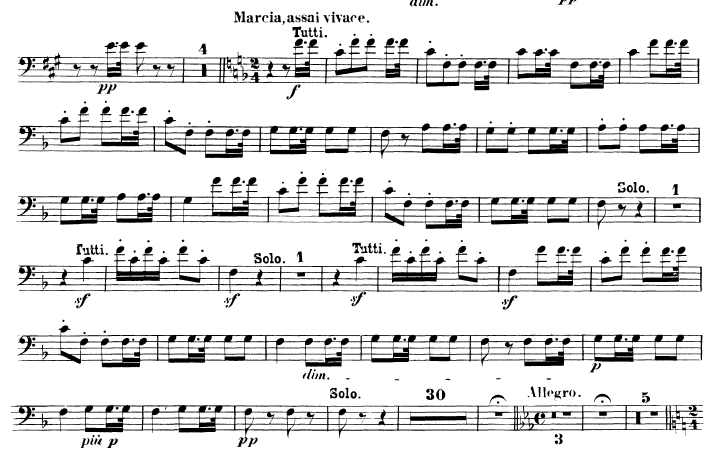Ludwig van Beethoven
Choral Fantasy, Op.80, March
- 1st and 2nd bassoon m. 322-357 (35 total measures)
- Range – (low F–F above the staff)
- Bass clef only
Performance issues: Phrasing, Rhythm, Articulation

About the music: This portion of the work is suggestive of some of the famous Beethoven “Turkish March” moments in other compositions. Scored for oboes, bassoons, horns, trumpets, timpani and strings, this particular excerpt has an instrumentation that harks back to the Bach and Handel open-air suites with double reeds, brass, strings and timpani. The solo piano is, of course, decidedly un-Baroque, so the throw-back never occurs—unless this portion is played out of context, and then the effect lasts only until the next piano entrance. The piano alternates with the orchestra in the measures of rest interspersed in the excerpt.
One needs to effect a very “jagged” feel in the dotted rhythms, a stylization of the articulation as well as in the note placement. This will, of course, have to be a unified effort in the whole wind section. Another important item for the bassoonist is the knowledge that the measure starts with notes played on beat one in the oboes and horns. Knowing one’s entrance, even to the writing in of a rhythmic cue, is a primary rehearsal concem.
About performing the excerpt: The pick-up notes which begin the excerpt determine the phrasing later in the passage: all melodic motives should be phrased in the same way. The melody is to be played in the style suggested by the representative staccato marks, so the general effect is quite angular. Considerable effort must be put into keeping all note values short. Rhythmic consistency will be a major issue for the player, and playing the two parts together will help the student set rhythm, style, and pitch.
Both parts should be learned since they are in different ranges. Additionally, this excerpt could be practiced along with the previous excerpt, since they are both from the same large work; they provide an exercise in contrasting articulations.